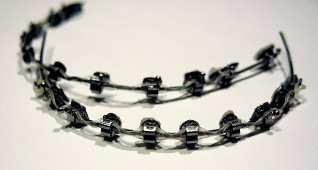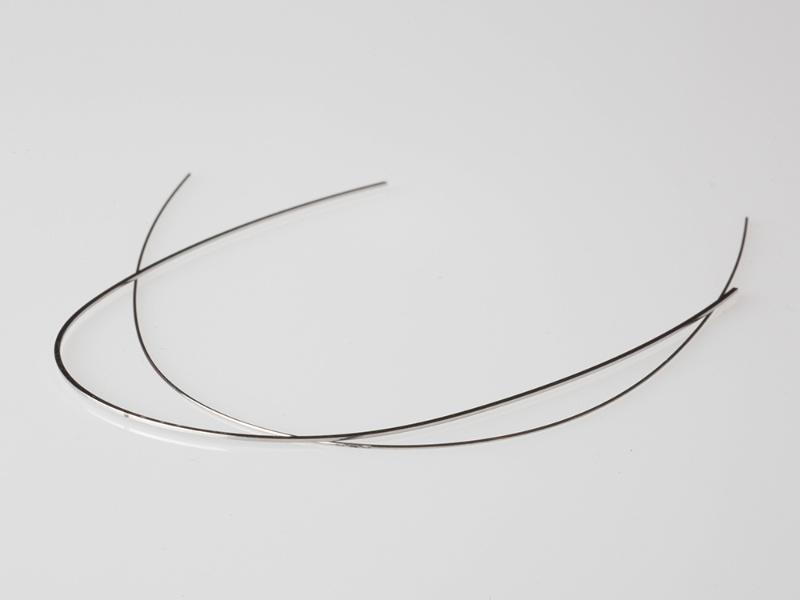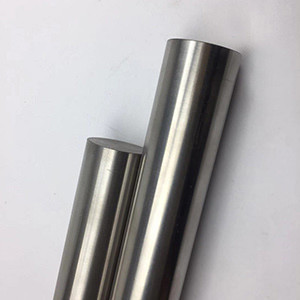What is nitinol wire and where is it used?
Nitinol is a metal alloy of nickel and titanium with unique properties, including superelasticity or pseudoelasticity and “shape memory” properties. That means nitinol can remember its original shape and return to it when heated. It also shows great elasticity under stress.We offer Nitinol wire for uses as dental braces and other medical applications.
Medical applications for nitinol include:
- Dentistry, especially in orthodontics for wires and brackets that connect the teeth. “Sure Smile” dental braces are an example of its application in orthodontics.
Endodontics, mainly during root canals for cleaning and shaping root canals. - In colorectal surgery, the material is used in various devices for reconnecting the intestine after a pathology is removed.
Stents. - Orthopedic implants.
- Nitinol Wires for marking and locating breast tumors.
- Tubing for a range of medical applications.
Why is nitinol used in dental braces?
Nitinol wire “remembers” its former shape. Nitinol relates to your braces treatment in a couple of ways: Instead of using stainless steel, nitinol can be used for your arch wire – the wires connecting the braces brackets. Traditional stainless steel wires have a tendency to lose tension over time.

How are shape memory alloys used in braces?
Nickel-titanium (NiTi) shape-memory alloys (SMAs) have been used in the manufacture of orthodontic wires due to their shape memory properties, super-elasticity, high ductility, and resistance to corrosion. SMAs have greater strength and lower modulus of elasticity when compared with stainless steel alloys.We offer Nitinol wire for uses as dental braces and other medical applications.
The Advantages Of Nitinol Wire For Braces
Nitinol is a metal alloy – or mixture – of nickel and titanium. This type of wire is also known as “memory wire” or “smart wire,” and it can be used as one of the parts of braces.
What is so smart about it? When heated, nitinol wire changes back into its former shape. To illustrate the properties of this wire, consider this scenario: Take a strand of the wire and bend it into a curved shape. If you try to straighten the wire back out, you won’t be able to; however, if you heat the wire, with a hairdryer for example, you will find that the wire reforms itself into the exact shape it was before you bent it. The wire “remembers” its former shape.
Nitinol relates to your braces treatment in a couple of ways:
- Instead of using stainless steel, nitinol wire can be used for your arch wire – the wires connecting the braces brackets.
- Traditional stainless steel wires have a tendency to lose tension over time. When the wire becomes slack, you must go to the dentist to have the wire adjusted.
- To use nitinol for your arch wire, your orthodontist will mold the wire to the current shape of your teeth. After the wire is placed in your mouth, it will begin to heat up. As it heats up, the wire will try to reform into a straighter shape.
- As the memory wires tries to straighten out, it will exert gradual pressure on your teeth. Pressure over time is how teeth are moved in orthodontia.
- The primary advantage of the memory wire in orthodontia is fewer trips to the dentist for adjustments.
How strong is Nitinol wire?
The Nitinol Memory toy is made of nitinol wire with a low transition temperature (the temperature of hot water). The force generated when the wire is reverting is surprisingly strong. One square inch of Nitinol material generates a shape returning force of + 30,000 PSI.
Why is Nitinol difficult?
It is difficult to make Nitinol due to the exceptionally tight compositional control required and the high reactivity of titanium. Every atom of titanium that combines with oxygen or carbon, is an atom taken from the Nitinol lattice, thus shifting the transformation temperature lower.
Are braces made from Nitinol?
Nitinol is used for the wiring and brackets that connect teeth. It’s the perfect choice for braces because the alloy is able to bend and shape itself to the requirements of the patient’s tooth formation. In endodontics, Nitinol is used during root canals, specifically for cleaning and helping to shape the root canal.
How is nitinol wire used in braces?
In orthodontics, the archwires that control your brackets and move your teeth are made from nitinol.
Your orthodontist will mould your archwire to fit your teeth. The warmth from your mouth will then activate the wire’s shape memory, and it will gradually move back towards its original shape – a perfect arch.
As the wire straightens, it gently applies pressure to your brackets and teeth, steadily aligning your smile little by little.
Nitinol archwires vs stainless steel
Nitinol archwires offer more advantages than their excellent shape memory. They’re biocompatible, resistant to corrosion and very reliable.
Superelastic nitinol is 10–30 times more flexible than stainless steel. It’s also more stable and releases nickel slower than stainless steel.
(If a patient has a nickel allergy, Invisalign is an excellent alternative to fixed braces.)
Unlike nitinol wire, traditional stainless-steel wires lose their ability to return to their original shape over time, so they lose tension and become slack. Your orthodontist will need to change the archwire when this happens to keep your teeth moving.
The main advantage of nitinol over stainless steel wires is fewer visits to the orthodontist for adjustments.
Nitinol wire and stainless steel wires are commonly used in orthodontic treatment. Stainless steel wire is introduced at the end for better control of accurate results.
For more information about nitinol products, please contact our office.


